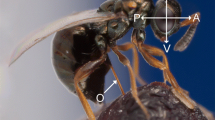Summary
In this study, immunohistochemistry on cryostat sections is used to demonstrate anti-histamine immunoreactivity in the Drosophila brain. The results support earlier findings that histamine is probably a transmitter of insect photoreceptors. It is further shown that, in Drosophila, all imaginal photoreceptors including receptor type R7 are anti-histamine immunoreactive, whereas the larval photoreceptors do not seem to contain histamine. In addition to the photoreceptors, fibres in the antennal nerve and approximately 12 neurons in each brain hemisphere show strong histamine-like immunoreactivity. These cells arborize extensively in large parts of the central brain.
Similar content being viewed by others
References
Bolwig N (1945/46) Senses and sense organs of the anterior end of the house fly larvae. Vidensk Medd Dan Naturhist Foren Khobenhavn 109:81–217
Buchner E, Buchner S, Crawford G, Mason WT, Salvaterra PM, Sattelle DB (1986) Choline acetyltransferase-like immunoreactivity in the brain of Drosophila melanogaster. Cell Tissue Res 246:57–62
Buchner E, Bader R, Buchner S, Cox J, Emson PC, Flory E, Heizemann CW, Hemm S, Hofbauer A, Oertel WH (1988) Cell-specific immuno-probes for the brain of normal and mutant Drosophila melanogaster. I. Wildtype visual system. Cell Tissue Res 253:357–370
Cagan RL, Ready DF (1989) The emergence of order in the Drosophila pupal retina. Dev Biol 136:346–362
Campos-Ortega JA, Jürgens G, Hofbauer A (1979) Cell clones and pattern formation: studies on sevenless, a mutant of Drosophila melanogaster Roux Arch 186:27–50
Datum KH, Weiler R, Zettler F (1986) Immunocytochemical demonstration of gamma-aminobutyric acid and glutamic acid decarboxylase in R7 photoreceptors and C2 centrifugal fibres in the blowfly visual system. J Comp Physiol [A] 159:241–249
Elias MS, Evans PD (1983) Histamine in the insect nervoussystem: distribution, synthesis and metabolism. J Neurochem 41:562–568
Elias MS, Evans PD (1984) Autoradiographic localization of 3H-histamine accumulation by the visual system of the locust. Cell Tissue Res 238:105–112
Fischbach K-F, Dittrich A (1989) The optic lobe of Drosophila melanogaster. Part I. A Golgi analysis of wild-type structure. Cell Tissue Res 258:441–475
Fortini ME, Rubin GM (1990) Analysis of cis-acting requirements of the Rh3 and Rh4 genes reveals a bipartite organization to rhodopsin promotors in Drosophila melanogaster. Genes Dev 4:444–463
Griffiths GW, Boschek CB (1976) Rapid degeneration of visual fibres following retinal lesions in the dipteran compound eye. Neurosci Lett 3:253–258
Hardie RC (1984) Properties of photoreceptors R7 and R8 in dorsal marginal ommatidia in the compound eyes of Musca and Calliphora. J Comp Physiol [A] 154:157–165
Hardie RC (1987) Is histamine a neurotransmitter in insect photoreceptors? J Comp Physiol [A] 161:201–213
Hardie RC (1988) Effects of antagonists on putative histamine receptors in the first visual neuropile of the housefly (Musca domestica). J Exp Biol 138:221–241
Hardie RC (1989) A histamine-activated chloride channel involved in neurotransmission at a photoreceptor synapse. Nature 339:704–706
Hofbauer A, Buchner E (1989) Does Drosophila have seven eyes? Naturwissenschaften 76:335–336
Homberg U, Hildebrand JG (1991) Histamine-immunoreactive neurons in the midbrain and suboesophageal ganglion of the sphinx moth Manduca sexta. J Comp Neurol 307:647–657
Joseph DR, Sullivan PM, Wang Y-M, Kozak C, Fenstermacher DA, Behrendsen ME, Zahnow CA (1990) Characterization and expression of the complementary DNA encoding rat histidine decarboxylase. Proc Natl Acad Sci USA 87:733–737
Nässel DR, Holmquist MH, Hardie RC, Hakanson R, Sundler F (1988) Histamine-like immunoreactivity in photoreceptors of the compound eyes and ocelli of the flies Calliphora erythrocephala and Musca domestica. Cell Tissue Res 253:639–646
Nässel DR, Pirvola U, Panula P (1990) Histamine-like immunoreactive neurons innervating putative neurohaemal areas and central neuropile in the thoraco-abdominal ganglia of the flies Drosophila and Calliphora. J Comp Neurol 197:525–536
Pirvola U, Tuomisto L, Yamatodani A, Panula P (1988) Distribution of histamine in the cockroach brain and visual system: an immunocytochemical and biochemical study. J Comp Neurol 276:514–526
Power ME (1943) The brain of Drosophila melanogaster. J Morphol 72:517–559
Sarthy PV (1989) Histamine: a neurotransmitter candidate for photoreceptors in Drosophila melanogaster. Invest Ophthalmol Visual Sci 30 S:290
Schlemermayer E, Schütte M, Ammermüller J (1989) Immunocytochemical and electrophysiological evidence that locust ocellar photoreceptors contain and release histamine. Neurosci Lett 99:73–78
Simmons PJ, Hardie RC (1988) Evidence that histamine is a neurotransmitter of photoreceptors in the locust ocellus. J Exp Biol 138:205–219
Steller H, Fischbach K-F, Rubin GM (1987) Disconnected: a locus required for neuronal pathway formation in the visual system of Drosophila. Cell 50:1139–1153
Stocker RF, Lawrence PA (1981) Sensory projections from normal and homeotically transformed antennae in Drosophila. Dev Biol 82:224–237
Strausfeld NJ (1976) Atlas of an insect brain. Springer, Berlin Heidelberg New York
Strausfeld HJ, Wunderer H (1985) Optic lobe projections of marginal ommatidia in Calliphora erythrocephala specialized for detecting polarized light. Cell Tissue Res 242:163–178
Tomlinson A, Ready D (1986) Sevenless: a cell specific homeotic mutation of the Drosophila eye. Science 231:400–402
Wada S (1974) Spezielle randzonale Ommatidien der Fliegen (Diptera: Brachycera): Architektur und Verteilung in den Komplexaugen. Z Morphol Tiere 77:87–125
Wolf R, Gebhardt B, Gademann R, Heisenberg M (1980) Polarization sensitivity of course control in Drosophila melanogaster. J Comp Physiol 139:177–191
Wunderer H, Smola U (1982a) Fine structure of ommatidia at the dorsal eye margin of Calliphora erythrocephala Meigen (Diptera: Calliphoridae): an eye region specialized for the detection of polarized light. Int J Insect Morphol Embryol 11:25–38
Wunderer H, Smola U (1982b) Morphological differentiation of the central visual cells R7/R8 in various regions of blowfly eye. Tissue Cell 14:341–358
Author information
Authors and Affiliations
Rights and permissions
About this article
Cite this article
Pollack, I., Hofbauer, A. Histamine-like immunoreactivity in the visual system and brain of Drosophila melanogaster . Cell Tissue Res 266, 391–398 (1991). https://doi.org/10.1007/BF00318195
Accepted:
Issue Date:
DOI: https://doi.org/10.1007/BF00318195




